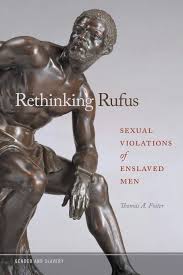Rethinking Rufus

A friend and colleague recently loaned me Thomas A. Foster’s Rethinking Rufus: Sexual Violations of Enslaved Men. The first monograph to tackle the difficult issue of sexual violence against enslaved men in the United States, it is an important study. It is also chilling and horrific, bringing a deeper and different kind of understanding to the evil that was slavery.
Foster is a historian and dean at Howard University, a scholar who works on issues of sexuality, gender and slavery. Foster knows both theory and history, and is as comfortable with primary sources as he is with queer theory. That range and skill set gives Foster the ability to re-examine and re-cast historical accounts through different eyes and with different tools. Perhaps the best example of that is drawn from the book’s very title.
Rose Williams was a former slave who was interviewed by the WPA in the 1930s as part of a slave narrative project. These interviews and other first-hand accounts of slavery are well-known to historians. Williams’ account, which the book includes in its entirety, tells of her forced pregnancy by Rufus, another slave, who she characterizes as a “bully.” Williams had two children by Rufus, her first at the age of sixteen. Once freed from bondage, Williams also freed herself from Rufus. It’s a terrible account of a woman’s hardship. Foster explain the story and also looks at it from a different perspective, that of the enslaved man. Rufus had no agency in the matter. As a slave, he was forced into the relationship. Male slaves had extremely limited agency when it came to issues of sexuality, as the book explains. Rufus’s body was a symbol and site of enslaved violation.
Rethinking Rufus’s chapters look at key themes without following a traditional chronology. Foster draws from a wide range of primary sources, from court cases to songs to art. Chapter One examines the objectification and distortions around black men’s bodies. Chapter Two explores manly autonomy and intimacy; families and more “traditional” forms of living a male ideal as husband and father were impossible in slavery. The ugliness of coerced reproduction is explored in the third chapter. Foster provides an overview of the debates with scholarship over the years, sketches the ways that the issue was interpreted, and concludes that the practice was widespread and a key component in the narrative of pain and suffering of slaver. Chapter Five focuses on white women and enslaved black men; the penultimate chapter looks for ways of exploring same-sex relationships in slavery. The historical record does not offer the scholar much of direct sources. Foster’s conclusion calls for a rethinking of the community in slavery.
The book is well-researched, well-written and well-argued. I expect that it will be taught for many years to come. It is also an important reminder that as we do more research and more work on slavery, the more we are aware of its lasting evil.
David Potash